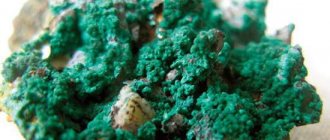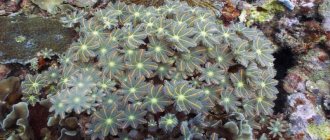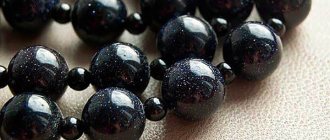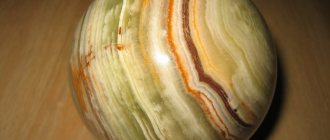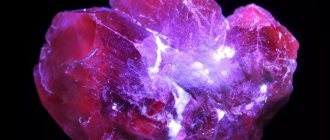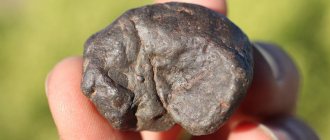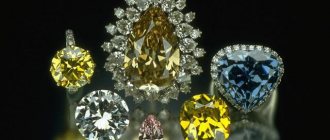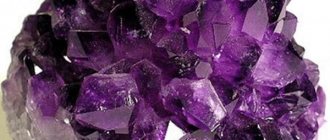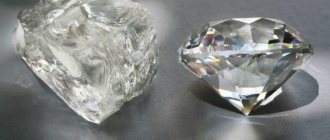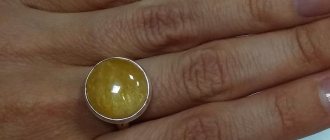Nuumite stone - its magical properties are known to esotericists, but it continues to intrigue others with its mystery and interesting characteristics. This mineral is the most popular in its homeland in Greenland. And the mineral received its properties due to its shimmering surface, which hides and conceals powers. This is a rare gemstone that you will not find in jewelry in jewelry stores. Most often, processed specimens are used; they can be found at lithotherapy sessions and in the collection of esoterics.
Characteristics of the mineral
Nuumite stone is based on jadeite and anthophyllite. In the scientific literature it is called anthophyllite-hedrite. Impurities include copper, pyrite (magnetic and copper), aluminum, augite, pyrite, and garnet. And each component gives the Greenlander a special color and pattern. No minerals of the same pattern were found. Gray, brown, black interspersed with red, yellow, green, blue - what colors can you find in a seemingly monochromatic dark stone!
Nuumite stone
The highlight of the colors is iridescence. The optical glow effect gives the nuumite a mysterious, unique appearance.
The hardness of the mineral on the Mohs scale is 6–7 points. The cost is high because the nuumite deposit is located in an inaccessible place, the stone is mined only in the summer, the quantity of raw materials is limited, and there is a demand.
| Other names | nuummit, numite, nummit, nuumite, nummite |
| Chemical composition | anthophyllite (Anthophyllite (Mg,Fe)7(OH)2[Si8O22]) and gedrite or gedrite, Gedrite Mg2(Mg3Al2)(Si6Al2)O22(OH)2) |
| Colors | black with inclusions, brown, brown-red, brown-green; presence of iridescence - blue, blue-yellow, yellow-green, blue-green shades |
| Mohs hardness | 6-7 |
| Density | 3.3-3.8 |
| Radioactivity | not recorded |
| Stroke color | white |
| Shine | glass |
In addition to Danish Greenland, this mineral is also found in small quantities in Norway, the USA, and Canada. But Greenlandic is considered the true and most popular.
Nuumites
Origin
The name came to us from ancient Greek. It can be literally translated as “onion stone.” It's very simple: onion - the color of leeks, which are eaten in the Balkans. Artificial nuumite is obtained by heating quartz, during which it changes its color and becomes soft green (it is recommended to look at the photo).
There are pebbles with which our mineral can be confused, we list them:
amethyst; beryl; tourmaline; peridot. At the same time, its characteristics deteriorate somewhat, but not critically. It can also be used in jewelry making. I must add that it is inexpensive, although quite beautiful. Its excellent lighting qualities are especially noted. Brazilian quartz or amethyst are best suited for making nuumite. Good preparations are also mined in the USA.
How does a stone heal?
Lithotherapists (doctors who study the effect of natural stones on the human body) continue to study the healing properties of the new mineral. It turned out that Nuumite:
- Treats migraine by relieving headaches.
- Relieves insomnia.
- Improves a person’s psycho-emotional health, reduces depression, and promotes the treatment of central nervous system diseases.
- Facilitates the condition of patients with Parkinson's disease.
- Increases immunity.
- Relieves eye infections.
- Normalizes blood sugar.
- Extinguishes the inflammatory process in the pancreas, anesthetizes the organ.
- Fights pathologies of the heart and blood vessels.
- Helps remove kidney stones.
- Accelerates tissue regeneration after injuries.
There is evidence that the mineral prevents the appearance of malignant tumors . However, this is not a cure for cancer, but only a companion remedy.
Black stones
My amulet
My beloved angel, my dear person. I carry your image in my heart like a talisman. The one that the gray wise men give from the evil eye is as if drunk from you and has no head. Tell your fortune by candlelight under the moon, You will be my thread, and I will be your string. I am above the abyss, but you keep me from jumping, Your strength and power over me is great. You can control it like Master Yoda, Give me the end of the thread so I don’t fall down. When you appeared, the string began to tremble. You must have been destined for me by God. I'm deprived of my head, it's like I'm drunk on you, Or like I was smoking a very strong hookah. I carry your image in my heart as a talisman, Joy, you are my angel, dear person. (Dmitry Kutepov)
What magicians and astrologers say about the mineral
The magical properties of the Nuumite stone have not been fully studied. Not every esotericist can work with it, since its effect on the psyche and capabilities of a person is contradictory. There is no doubt that only a truly capable person with good intentions can use the stone for healing and rituals. If you have dark thoughts, Nuumite can cause harm.
Crystal
Because of its uniqueness and originality, Greenland stone has gained a reputation as a powerful magical tool. When a strong magician takes it in his hand, the stone begins to glow from within, and at the moment of the impact itself it reveals a multi-colored pattern.
The magic of the mineral is manifested in the fact that it:
- Changes the owner’s energy field for the better: absorbs and transforms bad energy into benign energy.
- Protects the owner from energy vampires.
- Allows you to look into the past and future, see your destiny and build a life path.
- Teaches you to forgive.
- Protects against damage, evil eye, love spells.
Ring with Nuumite
Shamans who use volcanic stone in rituals travel to the other world and heal restless souls. Only magicians with very strong abilities can work with it. The weak risk going crazy. Several such cases have been recorded.
Earrings with Nuumite
As for astrological properties, it is impossible to unequivocally answer the question of whose zodiac sign this mineral is suitable for. There are only general recommendations: since Nuumite was born from a volcano, it is suitable primarily for fire signs (Aries, Leo, Sagittarius), as well as earth signs (Capricorn, Taurus, Virgo) and water signs (Pisces, Cancer, Scorpio).
In principle, jewelry and amulets made from it are not contraindicated for others to wear, but the above recommendations must be kept in mind.
| Zodiac sign | Compatibility |
| Aries | +++ |
| Taurus | + |
| Twins | + |
| Cancer | + |
| a lion | +++ |
| Virgo | + |
| Scales | + |
| Scorpion | + |
| Sagittarius | +++ |
| Capricorn | + |
| Aquarius | + |
| Fish | + |
(“+++” – fits perfectly, “+” – can be worn, “-” – is strictly contraindicated).
A person chooses a stone, and a stone chooses its owner. Both should feel attraction at the moment of choice. Then the gem will become a real talisman.
Who is suitable for a Nuumite talisman?
The stone can only be used in a good way, otherwise it will break a person or drive him crazy.
It must be borne in mind that the stone favors only honest people who do not wish bad things on others. It is dangerous for black sorcerers to wear jewelry made from an amazing breed. Weak in spirit and beginners who are just starting to practice magic also need to remain careful, because the Nuumite will break them and bend them to its own will. A common consequence of thoughtless use is insanity.
The stone is suitable for any sign of the zodiac belt, if used with respect. However, it is better for Air signs to choose another gem. Volcanic rock favors Aries, Leo and Sagittarius most of all; Capricorn and Virgo will feel less tangible support. The stone is indifferent to the water signs of the zodiac belt, and therefore it takes time to gain trust and get help.
Use in crafts
Nuumite is used in jewelry. Men's and women's jewelry is created: rings, rings, bracelets, beads.
Product with nuumite
Nuumite is polished, leaving no edges.
As a rule, high-quality jewelry is made from it, but expensive items are also common. Most often they are set in silver, since it is this metal that emphasizes the originality and beauty of a rare iridescent and sparkling stone. But gold is not suitable for volcanic stone.
Nuumite fades under the influence of ultraviolet radiation, this must be taken into account and protected from direct sunlight. Carefully care for the products, without using abrasives or chemicals for cleaning.
Nuumite mineral
It is difficult for ordinary stone lovers to distinguish a fake from a real Nuumite. Unscrupulous manufacturers pass off the more common feldspar and other minerals as nuumite. If you decide to purchase a mineral for magical purposes, this must be done near the deposit in Nuuk. Or better yet, find it yourself. Then his significance as a strong magical protector will be fully revealed. When buying jewelry made from a precious mineral, find out its history and origin.
nummite stone
The combination of jadeite and anthophyllite forms not only nuumite. On all continents there are minerals with a similar composition and approximately the same color. For example, in our Karelia and the Far East, deposits of black stones are being developed, which have a strong iridescent effect and are interspersed with different shades.
Nuumite is one of the stones that most strongly affects the human bioenergy field. This is what makes it interesting. It is used, depending on the ailment, for massage, for charging water, and observing the glow. Perhaps some magical properties are just legends. But who is stopping him from testing his abilities in practice?
Definition
The Nuumite stone - prasiolite - is quite unusual. It is obtained artificially from quartz, but, interestingly, its analogues can still be found in nature. These are quartz, painted in light green tones. They also have a pleasant, quiet glow and are highly prized. Of course, natural prasiolite is many times more expensive, but it is almost impossible to find. And you need to understand that, in essence, it is no longer the mineral that will be discussed now. It has extensive magical properties, somewhat similar in this sense to the Nuumite stone. Nuummite, although not artificial, is also considered one of the most powerful amulets. This will be discussed further.
Magic properties
The stone is credited with a positive effect on the spiritual side and its strong magical properties.
Bad thoughts upon contact with this mineral disappear, and the human field becomes impenetrable to external negativity.
It seems to help awaken high feelings, including respect for others, compassion and forgiveness. The positive aspects of character only intensify.
Nuumit became most widespread as an amulet of protection against the evil eye. It absorbs the wave of negativity and transforms it into positive vibrations.
It is believed that all zodiac signs can wear jewelry with this stone. It is best to choose silver items, because silver enhances the effect of Nuumite.
List of precious and semi-precious stones
The terms “gemstones” and “semi-precious stones” originated in the 1800s and were used to determine their commercial value, which depended solely on rarity. Stones that were found in large quantities were considered semi-precious, and those that were found rarely were considered precious. Diamonds, rubies, sapphires, emeralds were classified as precious stones. All other stones are classified as semi-precious stones. The difference between precious and semi-precious stones is their rarity and quality. Below you can find a list of precious and semi-precious stones that are often used for jewelry and other stone products.
Aventurine
Aventurine is a type of green quartz that is often used for cutting and cabochons.
Agate
Agate is a layered form of chalcedony quartz in a remarkable variety of colors and textures.
Dendritic agate
Dendritic agate is a whitish-gray or colorless chalcedony with fern-like inclusions known as dendrites. These inclusions look like plant material, but are actually iron or manganese.
Fire Agate
Fire agate is an opaque, limonite-bearing chalcedony with an iris effect caused by light diffraction in its layered structure.
Agate Geode
Agate geodes are a form of quartz chalcedony that forms in concentric layers in a remarkable variety of colors and textures in rock cavities or projections with internal crystal formations.
Aquamarine
Aquamarine is best known for its spectacular range of blue colors and is in the same group as emerald (beryl). Aquamarine is a hard stone and has a unique glassy luster.
Aquamarine Cat's Eye
Aquamarine is best known for its spectacular range of blue colors and is in the same group as emerald. Cat's eye aquamarine is quite rare.
Axinite
Axinite is a group of brown or violet-brown or reddish-brown minerals that are sometimes found as gemstones. Axinite is distinguished by its strong glassy luster.
Actinolite Cat's Eye
Actinolite cat's eye is a rare variety of multi-colored actinolite minerals. It is often called "cat's eye" due to its close relationship with jade stone, one of two forms of pure rocks. Actinolite and jade belong to the same series of minerals, ranging from iron-rich tremolite and magnesium-rich ferroactinolite amphiboles. Actinolite cat gemstones are usually translucent and range from jade green to yellow in color.
Alexandrite
Alexandrite is one of the rarest of all colored gemstones and is famous for its color changing from green under daylight to red under incandescent light.
Diamond
Diamond, the hardest known natural stone, is a transparent carbon crystal. Diamond is renowned not only for its superior hardness, but also for its high refractive index and dispersion.
Amazonite
Amazonite is a variety of green microcline, feldspar. It is named after the Amazon River in Brazil, although no deposits of this stone have been found there.
Amethyst
Amethyst is the most precious stone in the quartz group. Amethyst ranges in color from pale lilac to deep reddish purple.
Amethyst geode
Amethyst geode is the trade name for purple quartz that forms in rock cavities and is often sold under the names of such crystal clusters or crystal plates.
Ametrine
Ametrine is a form of quartz that occurs in bands of yellow and purple, with a combination of amethyst and citrine colors.
Ammolite
Ammolite is a rare organic gemstone that is fairly new to the market, with commercial mining only beginning in 1981.
Andalusite
Andalusite – has very distinct color combinations, and a very pronounced level of pleochroism, meaning it can display different colors when viewed from different angles.
Andesine-labradorite
Andesine labradorite is a fairly new gemstone. It occurs in a reddish-orange color, with traces of green and yellow, and also has a rare metallic sheen.
Apatite
Apatite stone is rarely found in jewelry stores, but is much loved by collectors for its variety of colors and shapes.
Apatite Cat's Eye
Apatite (cat's eye effect) is the reflection of light by parallel fibers, needles or channels that resemble the slit of a cat's eye.
peanut tree
Peanutwood is a variety of petrified wood where the shape and structure of the wood is preserved when the original organic material is replaced with quartz.
Turquoise
Turquoise, the blue cousin of lapis lazuli, has been known and valued for thousands of years. Early mines in Sinai, Egypt were already exhausted by 2000 BC.
Beryl
Beryl is one of the most important gemstone minerals. The most famous beryl is emerald, but there are other varieties of beryl including aquamarine, heliodor and morganite.
Variscite
Variscite is a relatively rare type of phosphate mineral. High quality specimens are used as gemstones and for cutting. Variscite is colored with traces of chromium.
Vesuvian
Vesuvianite is also known as vesuvianite, as it was originally found on Mount Vesuvius. The color is usually green, but it can also be brown, yellow, blue or purple.
Verdit
Verdite is a light-dark green snake-like breed that comes in multi-colored or variegated varieties. Most specimens are from South Africa and Zimbabwe.
Hakmanite
Hackmanite exhibits an unusual phenomenon known as reversible photochromicity, where the mineral changes color when exposed to sunlight.
Hambergite
Hambergite is one of the few known gemstones. It is usually almost colorless, with a vitreous luster of glass when cut. It is a fairly hard material with a hardness of 7.5.
Gaspeite
A relatively recent discovery (1966), gaspeite is a very rare nickel carbonate mineral named after the site in Eastern Canada where it was first described.
Heliotrope
Bloodstone, also known as heliotrope, is a green gemstone studded with bright red flecks of iron oxide.
Hematite
Hematite is an iron oxide that is usually blackish-gray. When polished, it can appear silvery. Hematite is an extremely dense material.
Hemimorphite
Hemimorphite usually occurs as an aggregate with blue and white stripes, or mixed with a dark matrix.
Giddenite
Hiddenite is a form of spodumene containing chromium. Green color varies from yellowish to blue-green.
Howlit
Howlite is an interesting grayish-white mineral that is sometimes called white turquoise due to its distinctive veining.
Goshenite
The colorless precious beryl is known as goshenite. It is named after the small town of Goshen in Western Massachusetts, where it was first described.
Almandine garnet
Almandin garnet is the most common garnet, dark brownish or purple-red. Garnet is very popular due to its excellent hardness and luster.
Hessonite garnet
Hessonite is an orange-brown garnet colored with traces of manganese and iron. It is sometimes called cyammon stone.
Grossular garnet
Grossularite (or grossular) garnet is a calcium-aluminum garnet. The name grossular comes from the botanical name of the gooseberry, grossularia.
Demantoid garnet
Demantoid garnet is the rarest and most valuable of the garnets. Found in green and emerald green, demantoid garnet is scarce and is usually only observed in small sizes.
Star Garnet
Star Garnet is a rare and unusual garnet found only in Idado in the United States and India. It displays a four-pointed star due to the even inclusions of rutile.
Garnet changing color
Color change garnet is a mixture of spessartite and pyrope garnet. This garnet presents a color change from brownish in daylight to pink in incandescent light.
Spessartite Garnet
The most valuable spessartite garnets have a bright orange-red color. The best examples are found in Namibia.
Tsavorite Garnet
A green type of garnet known as tsavorite was discovered in 1967 by British geologist Campbell R. Bridges in the bush along the border between Kenya and Tanzania.
Danburite
Danburite gets its name from Danbury, Connecticut, where it was first discovered in 1839. It is quite hard, measuring 7-7.5 on the Mohs scale.
Jasper
Jasper is generally considered chalcedony, but scientists classify it as a separate group due to its granular structure.
Diaspora Cat's Eye
Diaspore, sometimes sold as Sultanite, is a color-change gemstone from Turkey. It is quite rare.
Diaspore changing color
Diaspore, sometimes sold as sultanite, is a natural color-changing stone quarried in Turkey. The stone has recently been introduced to the international market.
Diopside Stellate
Diopside is a silicate of calcium and magnesium. Of all the diopsides, the bright green chrome diopside is the best known, but the black diopside, which exhibits asterism (also known as the star effect), is also important.
Enstatite
Enstatite is a rare gemstone that belongs to the pyroxene group of minerals. It is usually brown-green with a glassy sheen and is a collector's gem.
Jade
Jadeite comes in most shades, including pure white, pink, brown, red, orange, purple, blue, black and a range of greens.
Pearl
Pearls are products of bivalves (mainly oysters and mussels). They are composed of nacre, mainly calcium carbonate in the form of aragonite crystals.
Star Lemon Quartz
Star Lemon Quartz is a lemon yellow quartz color that displays asterism (star effect).
Star Moonstone
Moonstone is a combination of orthoclase and albite arranged in layers that produce a beautiful shine. Star Moonstone exhibits a stunning four-pointed star effect.
Star Quartz
Rose quartz displaying an asterism or star effect is quite rare. Rose quartz's unique soft color is thought to be caused by tiny traces of titanium.
Star Ruby
A star ruby is a ruby that displays an asterism, a six-pointed star that twinkles above the surface of the stone when it moves.
Star Sapphire
Star sapphire is a sapphire that contains unusual tiny needle-like inclusions. These needles produce a phenomenon called asterism.
Star Sunstone
Sunstone is a plagioclase feldspar with a unique luster from hematite platelets. It usually has a red sheen and less often blue or green. Star stones are known, but rare.
Emerald
Emerald is the most precious stone in the beryl group. The remarkable green color of emerald is unparalleled in the world of gemstones.
Iolite
Iolite has very pronounced pleochroism. One stone combines three different shades: purple, yellow-gray and blue.
Calcite
Pure calcium carbonate is colorless, but calcite is often colored by various impurities, including iron, magnesium, manganese, zinc, or cobalt.
Cassiterite
Cassiterite is one of the most valuable gemstone materials. It also has a very high refractive index, higher than zircon, sphene and demantoid garnet.
Quartz
Quartz is one of the most abundant minerals on Earth and is well known in the gemstone world in its many forms, including amethyst, citrine and ametrine.
Dumortierite quartz
Dumortierite quartz is an unusual quartz that grows with the mineral dumortierite. The inclusions of dumortierite give it a deep blue color that is unique in the world of quartz.
Smoky quartz
Smoky quartz was used to make magic balls. It is one of the few gemstones that is gray or brown in color.
Rutile quartz
Rutile quartz is clear or smoky quartz interspersed with rutile crystals.
Strawberry Quartz
Quartz with red flecks of lepidocrosite, hematite, or goethite is often sold as strawberry quartz.
Quartz cat eye
Quartz cat's eye is quartz in which inclusions of rutile create the effect of a cat's eye. Typically found in white, green, yellow or brown.
Clinohumite
>Clinohumite is a rare mineral and an especially rare gemstone. There are only three known sources of precious quality clinohumite material: Tajikistan, Siberia and Tanzania.
Coral
Gem coral is a type of coral that grows in rocky sea plateaus. Coral has a variety of warm reddish-pink colors, ranging from salmon pink to deep red.
Fossil Coral
Fossil coral is a decorative material that is formed when old coral is gradually replaced by agate. The proper name for this material is agate coral.
Cornerupin
Kornerupin - has a rare shade from transparent to translucent, the stone usually combines brownish-green colors. It was named after the Danish naturalist, artist and explorer Andreas Nikolaus Kornerup.
Kunzite
Kunzite combines a palette of pink-violet to light purple species of the mineral spodumene. Kunzite is named after mineralogist George F. Kunz.
Kuanite
Kyanite is a layered crystal with a glassy to almost pearly luster that is typically found in a sapphire-like blue color.
Labradorite
Labradorite is a member of the plagioclase feldspar group and exhibits a distinctive play of colors in brilliant metallic shades.
Lapis lazuli
Lapis lazuli has been used for thousands of years in jewelry and decorative items. The unique deep blue color has never lost its appeal.
Larimar
The blue variety of pectolite became known as Larimar. A very rare mineral, it was only found in the Dominican Republic, first discovered in 1974.
Lepidolite
Lepidolite is a purple-gray or pink-lithium mineral of the mica group. It is one of the main sources of rare alkali metals rubidium and cesium.
Moon rock
Moonstone is a unique stone that reflects light in a peculiar shimmering phenomenon known as adulation.
Malachite
Malachite is a copper carbonate with a characteristic green vein. Although it is not a particularly hard stone, it is excellent for polishing.
Pomegranate Mali
Mali garnet is one of the hybrid garnets, a mixture of grossular and andradite garnets. It gets its name from the African country where it was first discovered.
Mau-sit-sit
Mau-sit-sith is an uncommon gemstone that is often classified as a member of the jade group. It was first discovered in 1963 and was named after a village in northwestern Burma.
Melanitis
Melanite is a black variety of the rare andradite garnet. It is sometimes called titanic andradite.
Moldavite
Moldavite is a bottle green, brownish green gemstone belonging to the tektite group. It is formed from vapors of condensed rock after the impact of a meteorite.
Morganite
The pink form of beryl was called morganite, in honor of the American banker and collector J.P. Morgan. Ranging from soft pink to purple, morganite is in the same group as emerald.
Moss Opal
Moss Opal is a milky white opal with unique inclusions of green horn hoops in moss-like patterns.
Mystical Quartz
Mystic Quartz is the product of a new, high-tech enhancement process whereby a coating is applied to colorless quartz.
Nuumit
Nuumite is an opaque metamorphic rock with a rainbow play of colors. Its main constituent minerals are gedrite and anthophyllite.
Obsidian
Obsidian is a naturally occurring volcanic glass. It forms when felsic lava extruded from a volcano cools without crystal growth.
Onyx
Onyx is a black form of chalcedony, a cryptocrystalline form of quartz.
Opal
Each opal stone is unique. No other stone has such rich and varied variations. Opals are also the most delicate gemstones commonly worn.
Opal Walder
Walder opal is the second most important form of opal, after black opal. The name comes from the fact that the boulder's formwork is found embedded in ironstone boulders.
Fire opal
Fire opal is an unusual type of opal from Mexico that can be yellow, orange, or orange-red in color. Some fire opal gemstones are clear enough to be facet cut.
Opal doublet
An opal doublet consists of a piece of natural opal glued to a black backing, resulting in a more vibrant color.
Orthoclase
Orthoclase is a clear yellow feldspar resembling citrine quartz or yellow beryl found in Madagascar.
Paraiba tourmaline
Paraiba Tourmaline is a rare copper-bearing stone with a vibrant neon blue color. First found in Brazil in 1989, similar material has been found in Africa.
Nacre
Mother of pearl is an organic gemstone that comes from the inside of some mollusk shells. Mother of pearl is made primarily from calcium carbonate.
Peridot
Peridot belongs to the forsterite-phayalite mineral series. It is an idiochromatic stone, meaning that its color comes from the underlying chemistry of the mineral itself and not from impurities.
Petersit
Petersite is a breccia aggregate of hawk's eye and tiger's eye, with swirling colors of blue, rusty red, gold and brown.
Prehnite
Prehnite is a form of aluminum and calcium silicate that has a glassy to pearly luster. Available in yellow-green and brown-yellow. Original and interesting jewelry is made from prehnite.
Pyropian garnet
Pyrope garnet is the most famous of the red garnets. Its dark, blood red color often resembles that of a ruby.
Rainbow Moonstone
The combination of orthoclase and albite arranged in layers produces a beautiful shine. Despite the name, rainbow moonstone is actually a range of labradorites with multi-colored curls.
Rainbow Pyrite
Rainbow pyrite - recently discovered in Russia. The druse-shaped material is a layer of miniature pyrite crystals covering the matrix.
Rhodochrosite
Rhodochrosite usually occurs in aggregate form with alternating, zigzag-like light and dark bands.
Rhodolite garnet
Rhodolite garnet is the name applied to a mixture of pyrope and almandite. Rhodolite tends to be lighter in color than most other types of red garnet.
Rhodonite
Rhodonite is manganese iron, magnesium calcium silicate and is part of the pyroxenoid group of minerals.
Rose quartz
Rose quartz's unique soft pink color is believed to come from tiny traces of titanium. Rose quartz crystals tend to be cloudy, which makes the color more intense.
Rubellite Tourmaline
A vibrant pink-red tourmaline, often with a purple hue, is known as rubellite. This is one of the most valuable tourmaline flowers.
Ruby
Ruby is a red variety of corundum, the second heaviest substance on the Mohs scale, with a rating of 9. This combination of hardness and rich color makes the ruby very valuable.
Ruby in fuchsite
Ruby in fuchsite is a natural combination of ruby and fuchcite. This is an interesting and colorful stone, blue with emerald green fuchsite and pink, purple or red ruby flecks.
Rubin Zoisite
Ruby Zoisite is a natural combination of ruby and zoisite crystals in one piece. It is often used for cutting.
Sapphire
With excellent hardness, second only to diamond, sapphire is one of the four traditional gemstones.
Sapphire changing color
Some rare sapphires exhibit color changes under different lighting conditions. Color-shifting sapphires are typically blue in natural light and purple under incandescent light.
Scapolite
Scapolite is not known as a gemstone, but it can be a very attractive stone. Its color, which is usually bright yellow, orange, pink or purple, is its distinguishing feature.
Seraphinite
Seraphinite is the name for a specific form of clinochlore. The dark green color of the seraphinite is enhanced by the silvery and feathery shimmer caused by the mica flecks.
Cornelian
Carnelian is a brownish-red-orange variety of chalcedony quartz, colored by traces of small amounts of iron. Darker colors (red-brown to brown) are often called sarde.
Serpentine
Serpentine is a type of green magnesium silicate aggregate. It is used as a decorative stone or for cutting.
Sillimanite cat's eye
Sillimanite is a type of aluminum silicate that is related to both andalusite and kyanite. In fact, these three minerals have the same chemical composition but have different crystal structures.
Scapolite Cat's Eye
Scapolite is a sodium calcium aluminosilicate with a hardness of 5.5 to 6 on the Mohs scale. It is named after the Greek word for "stick" as its crystals are shaped like pillars.
Smithsonite
Smithsonite is one of two zinc-bearing minerals discovered by British mineralogist James Smithson. The zinc silicate was named smithsonite in his honor.
Snowflake Obsidian
Obsidian is a naturally occurring volcanic glass. In some stones, white cristobalite crystals are interspersed to create a mottled pattern known as obsidian snowflakes.
Sodalite
The mineral sodalite gets its name from its sodium content. As a gemstone, sodalite is typically blue, often with a purple tint, and also contains white veins of calcite.
Sun stone
Sunstone is a type of plagioclase feldspar that has a special luster due to the reflections of red hematite.
Spodumene
Spodumene is a relatively new mineral to science, and its gemstone species have only been discovered in the last 120 years. Spodumene comes in white, grey, pink, lilac and green.
Sugilite
Sugilite is a dark and rather rare mineral named after the Japanese geologist Ken-ichi Suga, who discovered it in 1944.
Sphalerite
Sphalerite is a rare collectible stone that has exceptional dispersion (also known as fire). In fact, its dispersion rate is three times higher than that of diamond.
Sphene
Sphene is a brilliant yellowish green, green or brown gemstone with a very high luster, unique color tones and a striking cut.
Tanzanite
Tanzanite is a range of zoisites. Tanzanite colors include blue, purple and green. The most desirable color is dark blue, which has purple pleochroism.
Tashmarine Diopside
Tashmarine Diopside is a brilliant yellow-green diopside, one of the recent discoveries in Tajikistan, Uzbekistan and Western China.
Eye of the Tiger
Tiger's Eye is an opaque macrocrystalline quartz with a fibrous structure. It usually displays frequent stripes and the structural fibers are curved or curved.
Tiger Eye Matrix
Tiger's Eye is the name given to a mineral aggregate in which a structure resembling a tiger's eye alternates with layers of iron hydroxides.
Topaz
Topaz is a sought-after stone due to its hardness and high refractive index. Topaz comes in many shades, but blue topaz is especially popular.
Nitric topaz
A new high-tech refinement process using thin film deposition created this new type of topaz.
Imperial topaz
The most sought after of all natural topaz is called imperial. Its rich golden color with reddish and orange overtones usually requires no further processing.
Topaz Mystical
Colorful Mystic Topaz is the product of a high-tech refinement process that is stable and permanent.
Topaz Rutile
Rutile topaz is a colorless topaz with inclusions that look like rutile crystals. But the inclusions are actually thin limonite channels.
Tremolite-hexagonite
Tremolite is a rare gemstone, sometimes called "hexagonalite" or "tremolite hexagonite."
Tourmaline
One of the most versatile gemstones, tourmaline comes in every color. It can display any tone from pastel to dark, and can combine different colors in one stone.
Tourmaline Cat's Eye
Tourmaline with tiny parallel flecks sometimes exhibits a strong cat's eye effect when polished.
Fluorite
Fluorite is a mineral with a variety of vibrant colors that include purple, blue, green, yellow, colorless, brown, pink and orange.
Chalcedony
Chalcedony is a fine-fibered variety of silica quartz. It has a waxy sheen and comes in a wide variety of colors.
Chrysoberyl
Faceted Chrysoberyl is a very beautiful stone that is not as well known as it deserves to be. In addition to very good hardness (8.5 on the Mohs scale), it has excellent gloss and polishes well.
Chrysoberyl Cat's Eye
The most famous and valuable cat's eye gemstone is chrysoberyl. It is valued for its excellent hardness (8.5) and pronounced cat's eye effect.
Chrysocolla
Chrysocolla is a hydrous copper silicate. Often confused with turquoise, chrysocolla is found in unusual multi-color combinations, as well as blue or green.
Chrysoprase
Chrysoprase is a chalcedony or cryptocrystalline quartz gemstone colored with trace amounts of nickel. Its color varies from green to green.
Chrome diopside
Chrome diopside, a bright green color, contains chromium, very similar to tsavorite garnet and chrome tourmaline.
Chrome tourmaline
Chrome tourmaline is a variety of tourmaline colored with chromium. It is sometimes called chrome dravite and is known for its rich green color.
Zircon
Zircon has excellent brilliance and intense brilliance due to its high refractive index and strong dispersion.
Citrine
Named after the French word for lemon, citrine is a yellow, gold, or orange-brown clear quartz.
Charoite
Charoite is a new stone on the market, first appearing in 1978. It is found in only one place in Siberia, Russia. The combination of lavender and violet flowers in a variety of forms is completely unique.
Spinel
Due to its superior hardness and clarity, spinel is an excellent gemstone for all types of jewelry. Spinel is never processed in any way.
Amber
Amber, the fossilized, hardened resin of pine trees, is one of the few gemstones of organic origin. Most of the amber is found in the Baltic states, where it was formed about 50 million years ago.
